从源码角度剖析 Spring 如何管理 mybatis 事务的? 原 荐
Ext1:本文源码解析基于 mybatis-spring-boot-starter 2.1.1,即 mybatis 3.5.3 版本。
Ext2:本文主要是对源码的讲解,着重点会是在源码上。
Ext3:阅读本文前,最好对 mapperProxy、 sqlSession 有一定的了解
一、 XMLMapperBuilder、mapperProxy 与 mapperMethod
上篇文章 讲了 mapper 文件是怎么解析的,在文章开头提到了 SqlSessionFactory 这个重要的对象,是的就是我们经常需要配置的:
@Bean
@ConditionalOnMissingBean
public SqlSessionFactory sqlSessionFactory(DataSource dataSource) throws Exception {
// 略
}
这里面做了很多自动化的配置,当然我们可以通过重写它来自定义我们自己的 sqlSessionFactory ,借用一下上篇文章的图片: 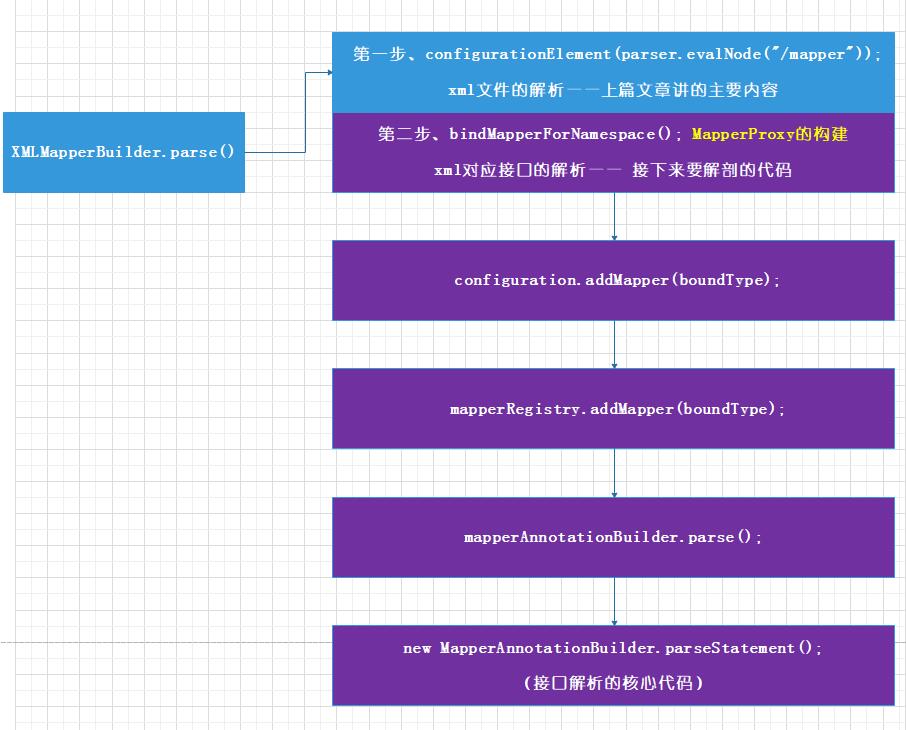
spring 借助 SqlSessionFactoryBean 来创建 sqlSessionFactory ,这可以视作是一个典型的建造者模式,来创建 SqlSessionFactory 。
上篇文章说到,spring 拿到我们配置的 mapper 路径去扫描我们 mapper.xml 然后进行一个循环进行解析( 上篇文章第二章节:二、SqlSessionFactory 的初始化与 XMLMapperBuilder ):
-- 代码位于 org.mybatis.spring.SqlSessionFactoryBean#buildSqlSessionFactory --
if (this.mapperLocations != null) {
if (this.mapperLocations.length == 0) {
LOGGER.warn(() -> "Property 'mapperLocations' was specified but matching resources are not found.");
} else {
for (Resource mapperLocation : this.mapperLocations) {
if (mapperLocation == null) {
continue;
}
try {
XMLMapperBuilder xmlMapperBuilder = new XMLMapperBuilder(mapperLocation.getInputStream(),
targetConfiguration, mapperLocation.toString(), targetConfiguration.getSqlFragments());
xmlMapperBuilder.parse();
} catch (Exception e) {
throw new NestedIOException("Failed to parse mapping resource: '" + mapperLocation + "'", e);
} finally {
ErrorContext.instance().reset();
}
LOGGER.debug(() -> "Parsed mapper file: '" + mapperLocation + "'");
}
}
} else {
LOGGER.debug(() -> "Property 'mapperLocations' was not specified.");
}
-- 代码位于 org.apache.ibatis.builder.xml.XMLMapperBuilder#parse --
public void parse() {
if (!configuration.isResourceLoaded(resource)) {
configurationElement(parser.evalNode("/mapper")); // 上篇文章主要说的
configuration.addLoadedResource(resource);
bindMapperForNamespace();// 创建mapperProxy的工厂对象
}
parsePendingResultMaps();
parsePendingCacheRefs();
parsePendingStatements();
}
1.1 从 xml 到 mapperStatement
上篇文章实际上就是在讲解 configurationElement(parser.evalNode("/mapper")); 里面发生的故事,实际上还有后续的步骤,如果对 mybatis 有所了解的,应该知道,mybatis 会为我们的接口创建一个叫做 mapperProxy 的代理对象(
bindMapperForNamespace(); 做的(不尽然,实际上是创建并绑定了
mapperProxyFactory
)。
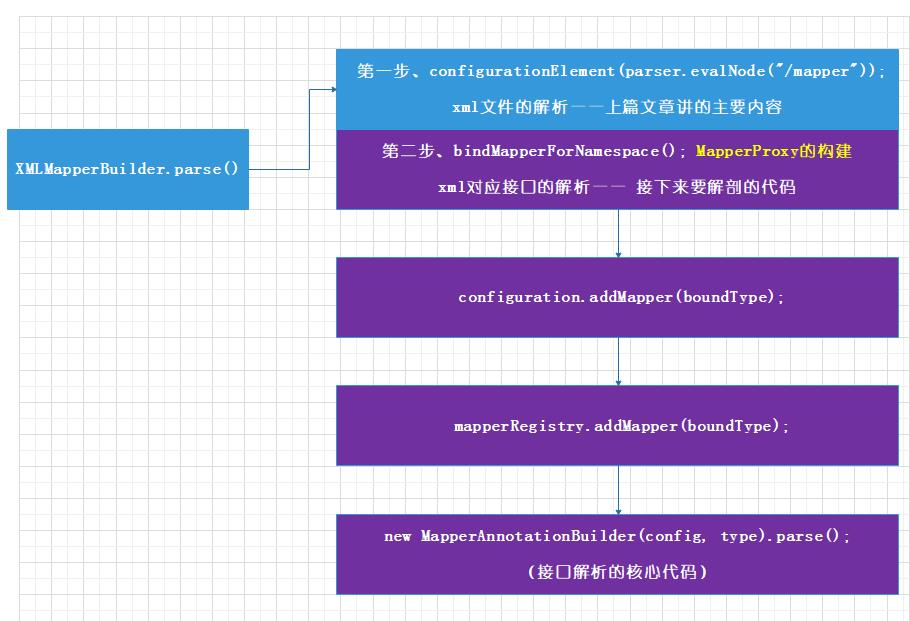
不贴太多代码, bindMapperForNamespace() 方法里核心做的主要就是调用 configuration.addMapper() 方法
if (boundType != null) {
if (!configuration.hasMapper(boundType)) {
// Spring may not know the real resource name so we set a flag
// to prevent loading again this resource from the mapper interface
// look at MapperAnnotationBuilder#loadXmlResource
configuration.addLoadedResource("namespace:" + namespace);
configuration.addMapper(boundType);
}
}
这个 boundType 就是我们在 mapper 文件里面指定的 namespace ,比如:
<mapper namespace="com.anur.mybatisdemo.test.TrackerConfigMapper">
XXXXXXXXXXXXXXXXXX 里面写的sql语句,resultMap 等等,略
</mapper>
在 configuration.addMapper() 中调用了 mapperRegistry.addMapper() ,看到 knowMappers ,这个就是存储我们生产 MapperProxy 的工厂映射 map,我们稍微再讲,先继续往下看。
public <T> void addMapper(Class<T> type) {
if (type.isInterface()) {
if (hasMapper(type)) {
throw new BindingException("Type " + type + " is already known to the MapperRegistry.");
}
boolean loadCompleted = false;
try {
knownMappers.put(type, new MapperProxyFactory<>(type));
// It's important that the type is added before the parser is run
// otherwise the binding may automatically be attempted by the
// mapper parser. If the type is already known, it won't try.
MapperAnnotationBuilder parser = new MapperAnnotationBuilder(config, type);
parser.parse();
loadCompleted = true;
} finally {
if (!loadCompleted) {
knownMappers.remove(type);
}
}
}
}
1.2 从注解到 mapperStatement
看到 MapperAnnotationBuilder#parse() , parse() 中主要是对这个接口里面定义的方法做了 parseStatement 这件事
for (Method method : methods) {
try {
// issue #237
if (!method.isBridge()) {
parseStatement(method);
}
} catch (IncompleteElementException e) {
configuration.addIncompleteMethod(new MethodResolver(this, method));
}
}
parseStatement() 就是解析注解语句的地方, 如果说我们没有写 xml,将语句以注解的形式写在方法上,则会在这里进行语句解析。它和我们上篇文章讲到的解析xml很像,就是拿到一大堆属性,比如 resultMap , keyGenerator 等等,生成一个 MappedStatement 对象,这里就不赘述了。
void parseStatement(Method method) {
Class<?> parameterTypeClass = getParameterType(method);
LanguageDriver languageDriver = getLanguageDriver(method);
SqlSource sqlSource = getSqlSourceFromAnnotations(method, parameterTypeClass, languageDriver);
if (sqlSource != null) {
// 解析注解式的 sql 语句,略
}
}
1.3 如果写了 xml,也写了注解会怎么样(调皮)
我们知道承载 mapperStatement 的是一个 map 映射,通过我们在上篇文章中反复强调的 id 来作为 key,那么重复添加会出现什么呢?
答案在这里, mybatis 的这个 map 被重写了,同时写这两者的话,会抛出 ...already contains value for... 的异常
-- 代码位置 org.apache.ibatis.session.Configuration.StrictMap#put --
@Override
@SuppressWarnings("unchecked")
public V put(String key, V value) {
if (containsKey(key)) {
throw new IllegalArgumentException(name + " already contains value for " + key
+ (conflictMessageProducer == null ? "" : conflictMessageProducer.apply(super.get(key), value)));
}
if (key.contains(".")) {
final String shortKey = getShortName(key);
if (super.get(shortKey) == null) {
super.put(shortKey, value);
} else {
super.put(shortKey, (V) new Ambiguity(shortKey));
}
}
return super.put(key, value);
}
1.4 回到 MapperProxy
1.4.1 MapperProxy 的创建
刚才在1.1中我们提到了, mapperProxy ,也就是刚才 org.apache.ibatis.binding.MapperRegistry#addMapper 的代码: knownMappers.put(type, new MapperProxyFactory<>(type));
看到 MapperProxyFactory 的内部:
-- 有删减 --
public class MapperProxyFactory<T> {
private final Class<T> mapperInterface;
private final Map<Method, MapperMethod> methodCache = new ConcurrentHashMap<>();
public MapperProxyFactory(Class<T> mapperInterface) {
this.mapperInterface = mapperInterface;
}
@SuppressWarnings("unchecked")
protected T newInstance(MapperProxy<T> mapperProxy) {
return (T) Proxy.newProxyInstance(mapperInterface.getClassLoader(), new Class[] { mapperInterface }, mapperProxy);
}
public T newInstance(SqlSession sqlSession) {
final MapperProxy<T> mapperProxy = new MapperProxy<>(sqlSession, mapperInterface, methodCache);
return newInstance(mapperProxy);
}
}
了解JDK动态代理的小伙伴应该很清楚了, newProxyInstance(ClassLoader loader, Class<?>[] interfaces, InvocationHandler h) 意为,为接口创建一个实现了 InvocationHandler 的代理对象。我们在调用接口方法的时候,实际上要看代理类是如何实现的。
那么看看 mapperProxy 的内部的 invoke 是如何实现的,这里有三类方法,
- 一种是一些
Object对象带来的方法,这里不进行代理,直接invoke, - 一种是default方法,一种比较蛋疼的写法,把接口当抽象类写,里面可以放一个default方法写实现,这种代理了也没太大意义
- 最后一种也就是我们准备代理的方法, 它会为每个非上面两者的方法,懒加载一个
MapperMethod对象,并调用MapperMethod#execute来执行真正的 mybatis 逻辑。
1.4.2 MapperMethod 的创建
-- 有删减 --
public class MapperProxy<T> implements InvocationHandler, Serializable {
public MapperProxy(SqlSession sqlSession, Class<T> mapperInterface, Map<Method, MapperMethod> methodCache) {
this.sqlSession = sqlSession;
this.mapperInterface = mapperInterface;
this.methodCache = methodCache;
}
@Override
public Object invoke(Object proxy, Method method, Object[] args) throws Throwable {
try {
if (Object.class.equals(method.getDeclaringClass())) {// 来自 Object 的方法,比如 toString()
return method.invoke(this, args);
} else if (method.isDefault()) {// 静态方法,我们可以直接忽略
if (privateLookupInMethod == null) {
return invokeDefaultMethodJava8(proxy, method, args);
} else {
return invokeDefaultMethodJava9(proxy, method, args);
}
}
} catch (Throwable t) {
throw ExceptionUtil.unwrapThrowable(t);
}
final MapperMethod mapperMethod = cachedMapperMethod(method);
return mapperMethod.execute(sqlSession, args);
}
private MapperMethod cachedMapperMethod(Method method) {
return methodCache.computeIfAbsent(method,
k -> new MapperMethod(mapperInterface, method, sqlSession.getConfiguration()));
}
}
MapperMethod 的逻辑是怎么样的,也很好猜到,它的构造函数中创建了两个对象,
public class MapperMethod {
private final SqlCommand command;
private final MethodSignature method;
public MapperMethod(Class<?> mapperInterface, Method method, Configuration config) {
this.command = new SqlCommand(config, mapperInterface, method);
this.method = new MethodSignature(config, mapperInterface, method);
}
- sqlCommand
sqlCommand 实际上就是从 configuration 里面把它对应的 MappedStatement 取出来,持有它的唯一 id 和执行类型。
public static class SqlCommand {
private final String name;
private final SqlCommandType type;
public SqlCommand(Configuration configuration, Class<?> mapperInterface, Method method) {
final String methodName = method.getName();
final Class<?> declaringClass = method.getDeclaringClass();
MappedStatement ms = resolveMappedStatement(mapperInterface, methodName, declaringClass,
configuration);
if (ms == null) {
if (method.getAnnotation(Flush.class) != null) {
name = null;
type = SqlCommandType.FLUSH;
} else {
throw new BindingException("Invalid bound statement (not found): "
+ mapperInterface.getName() + "." + methodName);
}
} else {
name = ms.getId();
type = ms.getSqlCommandType();
if (type == SqlCommandType.UNKNOWN) {
throw new BindingException("Unknown execution method for: " + name);
}
}
}
- MethodSignature
MethodSignature是针对接口返回值、参数等值的解析,比如我们的@Param注解,就是在new ParamNameResolver(configuration, method);里面解析的,比较简单,在之前的文章 简单概括的mybatis sqlSession 源码解析 里也提到过,这里就不多说了。
public MethodSignature(Configuration configuration, Class<?> mapperInterface, Method method) {
Type resolvedReturnType = TypeParameterResolver.resolveReturnType(method, mapperInterface);
if (resolvedReturnType instanceof Class<?>) {
this.returnType = (Class<?>) resolvedReturnType;
} else if (resolvedReturnType instanceof ParameterizedType) {
this.returnType = (Class<?>) ((ParameterizedType) resolvedReturnType).getRawType();
} else {
this.returnType = method.getReturnType();
}
this.returnsVoid = void.class.equals(this.returnType);
this.returnsMany = configuration.getObjectFactory().isCollection(this.returnType) || this.returnType.isArray();
this.returnsCursor = Cursor.class.equals(this.returnType);
this.returnsOptional = Optional.class.equals(this.returnType);
this.mapKey = getMapKey(method);
this.returnsMap = this.mapKey != null;
this.rowBoundsIndex = getUniqueParamIndex(method, RowBounds.class);
this.resultHandlerIndex = getUniqueParamIndex(method, ResultHandler.class);
this.paramNameResolver = new ParamNameResolver(configuration, method);
}
1.4.3 MapperMethod 的执行
mapperMethod 就是 sqlSession 与 mappedStatement 的一个整合。它的执行是一个策略模式:
public Object execute(SqlSession sqlSession, Object[] args) {
Object result;
switch (command.getType()) {
case INSERT: {
Object param = method.convertArgsToSqlCommandParam(args);
result = rowCountResult(sqlSession.insert(command.getName(), param));
break;
}
case UPDATE: {
Object param = method.convertArgsToSqlCommandParam(args);
result = rowCountResult(sqlSession.update(command.getName(), param));
break;
}
case DELETE: {
Object param = method.convertArgsToSqlCommandParam(args);
result = rowCountResult(sqlSession.delete(command.getName(), param));
break;
}
case SELECT:
// 略..
}
具体是怎么执行的在文章 简单概括的mybatis sqlSession 源码解析 提到过,这里也不过多赘述。
这里对 MapperProxy 在初始化与调用过程中的关系做一下罗列:
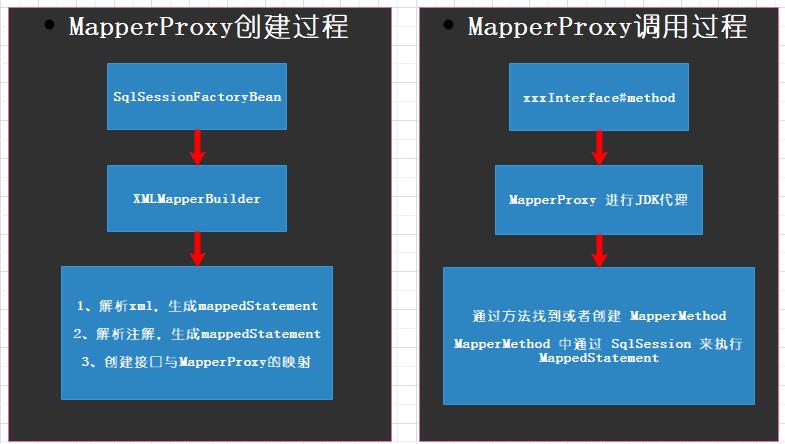
二、 下文序言
上面的 MapperProxy 讲解的比较粗略,因为真的很简单(复杂一点的在 MepperMethod 的策略模式,也就是调用 sqlSession 去执行语句的时候,但是那个本文不会详细说明,后续的文章会解析这部分代码)
本文要讲的是几个在很多文章或者书里都没有提到,或者只是简单提了一下的点:本文将会把 sqlSession、MapperProxy、Spring事务管理几个关联密切的功能点进行总结,比如如下这样的疑问:
- 1、我们知道一个 sqlSession 对应一个数据库连接,在创建 MapperProxy 的时候,又注入了 sqlSession ,难道我们用的一直是同一个 sqlSession?或者难道每次使用不同的数据库连接,会创建不同的 MapperProxy 代理?
- 2、事务传播等级是怎么实现的,和 sqlSession 有关系吗?
- 3、代理对象 MapperProxy 是如何和 spring 产生关联的?
三、 SqlSession 的初始化及其运作总览
为了避免有小伙伴对 sqlSession 完全没有概念,这里将接口代码贴出,可以看出 sqlSession 是执行语句的一个入口,同时也提供了事务的一些操作,实际上就是如此:
public interface SqlSession extends Closeable {
<T> T selectOne(String statement);
<T> T selectOne(String statement, Object parameter);
<E> List<E> selectList(String statement);
<E> List<E> selectList(String statement, Object parameter);
<E> List<E> selectList(String statement, Object parameter, RowBounds rowBounds);
<K, V> Map<K, V> selectMap(String statement, String mapKey);
<K, V> Map<K, V> selectMap(String statement, Object parameter, String mapKey);
<K, V> Map<K, V> selectMap(String statement, Object parameter, String mapKey, RowBounds rowBounds);
<T> Cursor<T> selectCursor(String statement);
<T> Cursor<T> selectCursor(String statement, Object parameter);
<T> Cursor<T> selectCursor(String statement, Object parameter, RowBounds rowBounds);
void select(String statement, Object parameter, ResultHandler handler);
void select(String statement, ResultHandler handler);
void select(String statement, Object parameter, RowBounds rowBounds, ResultHandler handler);
int insert(String statement);
int insert(String statement, Object parameter);
int update(String statement);
int update(String statement, Object parameter);
int delete(String statement);
int delete(String statement, Object parameter);
void commit();
void commit(boolean force);
void rollback();
void rollback(boolean force);
List<BatchResult> flushStatements();
void close();
void clearCache();
Configuration getConfiguration();
<T> T getMapper(Class<T> type);
Connection getConnection();
}
3.1 sqlSession 的创建
3.1.1 Environment 与 Transaction
首先忘掉 spring 为我们提供的便利,看一下基础的,脱离了 spring 托管的 mybatis 是怎么进行 sql 操作的:
SqlSession sqlSession = sqlSessionFactory.openSession();
TrackerConfigMapper mapper = sqlSession.getMapper(TrackerConfigMapper.class);
TrackerConfigDO one = mapper.getOne(1);
SqlSessionFactory 有两个子类实现: DefaultSqlSessionFactory 和 SqlSessionManager , SqlSessionManager 使用动态代理 + 静态代理对 DefaultSqlSessionFactory 进行了代理,不过不用太在意这个 SqlSessionManager ,后面会说明原因。
上面不管怎么代理,实际逻辑的执行者都是 DefaultSqlSessionFactory ,我们看看它的创建方法,也就是 openSession() 实际执行的方法:
private SqlSession openSessionFromDataSource(ExecutorType execType, TransactionIsolationLevel level, boolean autoCommit) {
Transaction tx = null;
try {
final Environment environment = configuration.getEnvironment();
final TransactionFactory transactionFactory = getTransactionFactoryFromEnvironment(environment);
tx = transactionFactory.newTransaction(environment.getDataSource(), level, autoCommit);
final Executor executor = configuration.newExecutor(tx, execType);
return new DefaultSqlSession(configuration, executor, autoCommit);
} catch (Exception e) {
closeTransaction(tx); // may have fetched a connection so lets call close()
throw ExceptionFactory.wrapException("Error opening session. Cause: " + e, e);
} finally {
ErrorContext.instance().reset();
}
}
environment 可用于数据源切换,那么提到数据源切换,就很容易想到了,连接的相关信息是这货维持的。 所以看到我们的代码: tx = transactionFactory.newTransaction(environment.getDataSource(), level, autoCommit); , TransactionFactory 有三个实现,它们分别是 JdbcTransactionFactory 、 ManagedTransactionFactory 和 SpringManagedTransactionFactory 。
JdbcTransactionFactory 和 ManagedTransactionFactory 最大的区别就在于 ManagedTransactionFactory 实现了空的 commit 与 rollback,源码中这样说道:付与容器来管理 transaction 的生命周期,这个博主不是特别熟悉,因为没这么用过,tomcat、jetty 等容器实现了对 jdbc 的代理。 要注意,不管如何都是使用的 jdbc 这套接口规范进行数据库操作的。
/**
* {@link Transaction} that lets the container manage the full lifecycle of the transaction.
* Delays connection retrieval until getConnection() is called.
* Ignores all commit or rollback requests.
* By default, it closes the connection but can be configured not to do it.
*
* @author Clinton Begin
*
* @see ManagedTransactionFactory
*/
Transaction 是 mybatis 创建的一个对象,它实际上是对 jdbc connection 对象的一个封装:
-- 代码位于 org.apache.ibatis.transaction.jdbc.JdbcTransaction --
@Override
public Connection getConnection() throws SQLException {
if (connection == null) {
openConnection();
}
return connection;
}
@Override
public void commit() throws SQLException {
if (connection != null && !connection.getAutoCommit()) {
if (log.isDebugEnabled()) {
log.debug("Committing JDBC Connection [" + connection + "]");
}
connection.commit();
}
}
@Override
public void rollback() throws SQLException {
if (connection != null && !connection.getAutoCommit()) {
if (log.isDebugEnabled()) {
log.debug("Rolling back JDBC Connection [" + connection + "]");
}
connection.rollback();
}
}
3.1.2 Executor 与 SqlSession
我们知道 sqlSession 的 四大对象之一,Executor,负责统领全局,从语句获取(从 mappedStatement),到参数拼装(parameterHandler),再到执行语句(statementHandler),最后结果集封装(resultHandler),都是它负责“指挥”的。
我们看到它使用 Transaction 进行初始化,另外的一个参数是它的类型,这里不多说,REUSE 是带语句缓存的,和普通的 SimpleExecutor 没有特别大的区别,BATCH 类型则是通过 jdbc 提供的批量提交来对网络请求进行优化。
public enum ExecutorType { SIMPLE, REUSE, BATCH}
最后将持有 Transaction 的 Executor 置入 SqlSession ,完成一个 SqlSession 对象的创建。
可以看到,我们的确是一个 SqlSession 对应一个连接( Transaction ), MapperProxy 这个业务接口的动态代理对象又持有一个 SqlSession 对象,那么总不可能一直用同一个连接吧?
当然有疑问是好的,而且通过对 SqlSession 初始化过程的剖析,我们已经完善了我们对 mybatis 的认知:
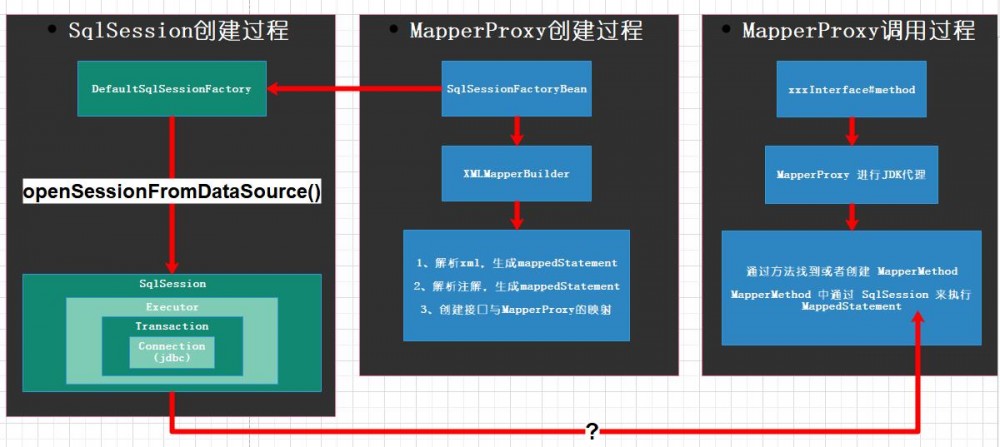
接下来就是来打消这个疑问, MapperProxy 持有的 sqlSession 和 SqlSessionFactory 创建的这个有什么关系?
3.2 SqlSessionTemplate 对 sqlSession 的代理
实际上答案就在 SqlSessionTemplate , SqlSessionTemplate 是 spring 对 mybatis SqlSessionFactory 的封装,同时,它还是 SqlSession 的代理。
SqlSessionTemplate 和 mybatis 提供的 SqlSessionManager ( SqlSessionFactory 的另一个实现类,也是 DefaultSqlSessionFactory 的代理类,可以细想一下,业务是否共用同一个 sqlSession 还要在业务里面去传递,去控制是不是很麻烦) 是一样的思路,不过 spring 直接代理了 sqlSession :
-- 代码位于 org.mybatis.spring.SqlSessionTemplate --
private final SqlSessionFactory sqlSessionFactory;
private final ExecutorType executorType;
private final SqlSession sqlSessionProxy;
private final PersistenceExceptionTranslator exceptionTranslator;
/**
* Constructs a Spring managed {@code SqlSession} with the given
* {@code SqlSessionFactory} and {@code ExecutorType}.
* A custom {@code SQLExceptionTranslator} can be provided as an
* argument so any {@code PersistenceException} thrown by MyBatis
* can be custom translated to a {@code RuntimeException}
* The {@code SQLExceptionTranslator} can also be null and thus no
* exception translation will be done and MyBatis exceptions will be
* thrown
*
* @param sqlSessionFactory a factory of SqlSession
* @param executorType an executor type on session
* @param exceptionTranslator a translator of exception
*/
public SqlSessionTemplate(SqlSessionFactory sqlSessionFactory, ExecutorType executorType,
PersistenceExceptionTranslator exceptionTranslator) {
notNull(sqlSessionFactory, "Property 'sqlSessionFactory' is required");
notNull(executorType, "Property 'executorType' is required");
this.sqlSessionFactory = sqlSessionFactory;
this.executorType = executorType;
this.exceptionTranslator = exceptionTranslator;
this.sqlSessionProxy = (SqlSession) newProxyInstance(
SqlSessionFactory.class.getClassLoader(),
new Class[] { SqlSession.class },
new SqlSessionInterceptor());
}
还是熟悉的配方,就是 jdk 的动态代理, SqlSessionTemplate 在初始化时创建了一个 SqlSession 代理,也内置了 ExecutorType , SqlSessionFactory 等 defaultSqlSession 初始化的必要组件。
想必看到这里,已经有很多小伙伴知道这里是怎么回事了,是的,我们对 SqlSession 的操作都是经由这个代理来完成,代理的内部,实现了真正 SqlSession 的创建与销毁,回滚与提交等,我们先纵览以下它的代理实现。
3.2.1 sqlSession 常规代理流程赏析
对于这种jdk动态代理,我们看到 SqlSessionInterceptor#invoke 方法就明了了。我们先过一遍常规的流程,也就是没有使用 spring 事务功能支持,执行完 sql 就直接提交事务的常规操作:
- 1、
getSqlSession()创建sqlSession - 2、执行
MapperProxy,也就是前面讲了一大堆的,MapperProxy中,通过MapperMethod来调用sqlSession和我们生成好的mappedStatement操作 sql 语句。 - 3、提交事务
- 4、关闭事务
注:代码有很大删减
private class SqlSessionInterceptor implements InvocationHandler {
@Override
public Object invoke(Object proxy, Method method, Object[] args) throws Throwable {
SqlSession sqlSession = getSqlSession(
SqlSessionTemplate.this.sqlSessionFactory,
SqlSessionTemplate.this.executorType,
SqlSessionTemplate.this.exceptionTranslator); // 创建或者获取真正需要的 SqlSession
try {
Object result = method.invoke(sqlSession, args); // 执行原本想对 SqlSession 做的事情
if (!isSqlSessionTransactional(sqlSession, SqlSessionTemplate.this.sqlSessionFactory)) {
// force commit even on non-dirty sessions because some databases require
// a commit/rollback before calling close()
sqlSession.commit(true);// 如非 spring 管理事务,则直接提交
} finally {
if (sqlSession != null) {
closeSqlSession(sqlSession, SqlSessionTemplate.this.sqlSessionFactory);
}
}
}
}
注意:注释掉的代码在此类型的操作中没有什么意义, getSqlSession() 在这里只是简单通过 sessionFactory 创建了一个 sqlSession :
public static SqlSession getSqlSession(SqlSessionFactory sessionFactory, ExecutorType executorType, PersistenceExceptionTranslator exceptionTranslator) {
// SqlSessionHolder holder = (SqlSessionHolder) TransactionSynchronizationManager.getResource(sessionFactory);
// SqlSession session = sessionHolder(executorType, holder);
// if (session != null) {
// return session;
// }
LOGGER.debug(() -> "Creating a new SqlSession");
session = sessionFactory.openSession(executorType);
// registerSessionHolder(sessionFactory, executorType, exceptionTranslator, session);
return session;
}
3.2.2 sqlSession 借助 TransactionSynchronizationManager 代理流程赏析
看完前面的实现,有小伙伴会好奇,我的@Transactional 注解呢?我的事务传播等级呢?
实际上,除去上述常规流程,更多的是要借助 TransactionSynchronizationManager 这个对象来完成,比如刚才步骤一, getSqlSession() 我暂时注释掉的代码里面,有一个很重要的操作:
我们把刚才 getSqlSession() 中注释掉的代码再拿回来看看:
SqlSessionHolder holder = (SqlSessionHolder) TransactionSynchronizationManager.getResource(sessionFactory);
SqlSession session = sessionHolder(executorType, holder);
if (session != null) {
return session;
}
session = sessionFactory.openSession(executorType);
registerSessionHolder(sessionFactory, executorType, exceptionTranslator, session);
return session;
我们可以看到 首先获取一个叫做 SqlSessionHolder 的东西 ,如果里面没有 sqlSession 则调用 sessionFactory.openSession(executorType); 创建一个, 并把它注册到 TransactionSynchronizationManager 。
sqlSessionHolder 没什么可说的,它就只是个纯粹的容器,里面主要就是装着一个 SqlSession :
public SqlSessionHolder(SqlSession sqlSession,
ExecutorType executorType,
PersistenceExceptionTranslator exceptionTranslator) {
notNull(sqlSession, "SqlSession must not be null");
notNull(executorType, "ExecutorType must not be null");
this.sqlSession = sqlSession;
this.executorType = executorType;
this.exceptionTranslator = exceptionTranslator;
}
所以说我们只需要把目光焦距在 TransactionSynchronizationManager 就可以了,它的内部持有了很多个元素为 Map<Object, Object> 的 ThreadLocal (代码示例中只贴出了 resources 这一个 ThreadLocal ):
public abstract class TransactionSynchronizationManager {
private static final Log logger = LogFactory.getLog(TransactionSynchronizationManager.class);
private static final ThreadLocal<Map<Object, Object>> resources =
new NamedThreadLocal<>("Transactional resources");
@Nullable
public static Object getResource(Object key) {
Object actualKey = TransactionSynchronizationUtils.unwrapResourceIfNecessary(key);
Object value = doGetResource(actualKey);
if (value != null && logger.isTraceEnabled()) {
logger.trace("Retrieved value [" + value + "] for key [" + actualKey + "] bound to thread [" +
Thread.currentThread().getName() + "]");
}
return value;
}
@Nullable
private static Object doGetResource(Object actualKey) {
Map<Object, Object> map = resources.get();
if (map == null) {
return null;
}
Object value = map.get(actualKey);
// Transparently remove ResourceHolder that was marked as void...
if (value instanceof ResourceHolder && ((ResourceHolder) value).isVoid()) {
map.remove(actualKey);
// Remove entire ThreadLocal if empty...
if (map.isEmpty()) {
resources.remove();
}
value = null;
}
return value;
}
也就是说,spring 的事务,是借助 TransactionSynchronizationManager + SqlSessionHolder 对 sqlSession 的控制来实现的。
那么这样就很清晰了,如下总结,也如下图:
-
MapperProxy内置的sqlSession是sqlSessiontemplate -
sqlSessiontemplate通过持有SqlSessionFactory来创建真正的SqlSession -
TransactionSynchronizationManager+SqlSessionHolder则扮演着SqlSession管理的角色
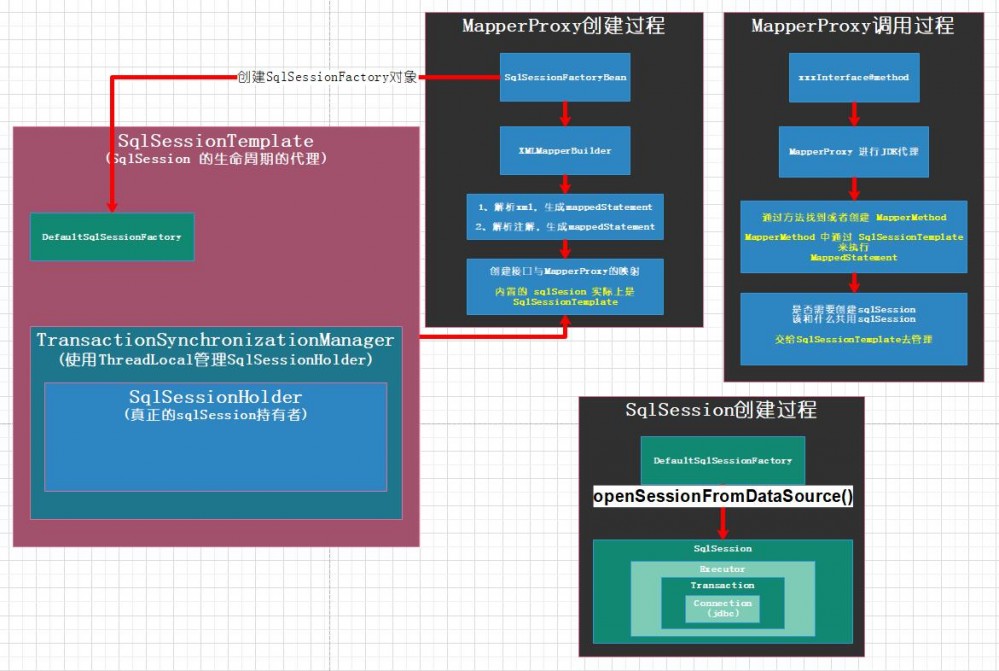
四、spring 如何管理 sqlSession
上一个小节只是讲了是什么,没有讲为什么,到了这里如果有好奇宝宝一定会好奇诸如 spring 的一系列事务控制是怎么实现的,当然本文不会讲太多 spring 事务管理相关的太多东西,以后会有后续文章专门剖析事务管理。
我们可以简单看下 TransactionInterceptor ,这是 @Transactional 注解的代理类。
/**
* AOP Alliance MethodInterceptor for declarative transaction
* management using the common Spring transaction infrastructure
* ({@link org.springframework.transaction.PlatformTransactionManager}/
* {@link org.springframework.transaction.ReactiveTransactionManager}).
*
* <p>Derives from the {@link TransactionAspectSupport} class which
* contains the integration with Spring's underlying transaction API.
* TransactionInterceptor simply calls the relevant superclass methods
* such as {@link #invokeWithinTransaction} in the correct order.
*
* <p>TransactionInterceptors are thread-safe.
*
* @author Rod Johnson
* @author Juergen Hoeller
* @see TransactionProxyFactoryBean
* @see org.springframework.aop.framework.ProxyFactoryBean
* @see org.springframework.aop.framework.ProxyFactory
*/
@SuppressWarnings("serial")
public class TransactionInterceptor extends TransactionAspectSupport implements MethodInterceptor, Serializable {
/**
* Create a new TransactionInterceptor.
* <p>Transaction manager and transaction attributes still need to be set.
* @see #setTransactionManager
* @see #setTransactionAttributes(java.util.Properties)
* @see #setTransactionAttributeSource(TransactionAttributeSource)
*/
public TransactionInterceptor() {
}
@Override
@Nullable
public Object invoke(MethodInvocation invocation) throws Throwable {
// Work out the target class: may be {@code null}.
// The TransactionAttributeSource should be passed the target class
// as well as the method, which may be from an interface.
Class<?> targetClass = (invocation.getThis() != null ? AopUtils.getTargetClass(invocation.getThis()) : null);
// Adapt to TransactionAspectSupport's invokeWithinTransaction...
return invokeWithinTransaction(invocation.getMethod(), targetClass, invocation::proceed);
}
可以看到它的代理方法 invoke() 的执行逻辑在 invokeWithinTransaction() 里:
--代码位于 org.springframework.transaction.interceptor.TransactionAspectSupport#invokeWithinTransaction --
@Nullable
protected Object invokeWithinTransaction(Method method, @Nullable Class<?> targetClass,
final InvocationCallback invocation) throws Throwable {
// If the transaction attribute is null, the method is non-transactional.
TransactionAttributeSource tas = getTransactionAttributeSource();
final TransactionAttribute txAttr = (tas != null ? tas.getTransactionAttribute(method, targetClass) : null);
final TransactionManager tm = determineTransactionManager(txAttr);
if (this.reactiveAdapterRegistry != null && tm instanceof ReactiveTransactionManager) {
// 响应式事务相关
}
PlatformTransactionManager ptm = asPlatformTransactionManager(tm);
final String joinpointIdentification = methodIdentification(method, targetClass, txAttr);
if (txAttr == null || !(ptm instanceof CallbackPreferringPlatformTransactionManager)) {
// Standard transaction demarcation with getTransaction and commit/rollback calls.
TransactionInfo txInfo = createTransactionIfNecessary(ptm, txAttr, joinpointIdentification);
Object retVal;
try {
// This is an around advice: Invoke the next interceptor in the chain.
// This will normally result in a target object being invoked.
retVal = invocation.proceedWithInvocation();
}
catch (Throwable ex) {
// target invocation exception
completeTransactionAfterThrowing(txInfo, ex);
throw ex;
}
finally {
cleanupTransactionInfo(txInfo);
}
if (vavrPresent && VavrDelegate.isVavrTry(retVal)) {
// Set rollback-only in case of Vavr failure matching our rollback rules...
TransactionStatus status = txInfo.getTransactionStatus();
if (status != null && txAttr != null) {
retVal = VavrDelegate.evaluateTryFailure(retVal, txAttr, status);
}
}
commitTransactionAfterReturning(txInfo);
return retVal;
}
else {
// CallbackPreferringPlatformTransactionManager 的处理逻辑
}
}
invokeWithinTransaction() 的代码虽然长,我们还是把它分段来看:
4.1 TransactionDefinition 与 TransactionManager 的创建
- 第一部分,准备阶段
也就是这部分代码:
// If the transaction attribute is null, the method is non-transactional. TransactionAttributeSource tas = getTransactionAttributeSource(); final TransactionAttribute txAttr = (tas != null ? tas.getTransactionAttribute(method, targetClass) : null); final TransactionManager tm = determineTransactionManager(txAttr); PlatformTransactionManager ptm = asPlatformTransactionManager(tm); final String joinpointIdentification = methodIdentification(method, targetClass, txAttr);
获取 TransactionAttribute ( TransactionDefinition (底层接口),这里面装载了事务传播等级,隔离级别等属性。 TransactionAttribute 的创建依据配置,或者我们的事务传播等级注解,对什么异常进行回滚等,后续会继续对它的应用做说明, PlatformTransactionManager 则是进行事务管理的主要操作者。
4.2 获取 TransactionInfo
- 第二部分,事务开启或者获取与准备,也就是我们执行逻辑的第一行代码
createTransactionIfNecessary()(是不是和前面说到的 SqlSession的创建或者获取很像?)
我们可以看到 createTransactionIfNecessary() 的实现就做了两件事,其一是获取一个叫做 TransactionStatus 的东西,另外则是调用 prepareTransactionInfo() ,获取一个 TransactionInfo :
// Standard transaction demarcation with getTransaction and commit/rollback calls.
TransactionInfo txInfo = createTransactionIfNecessary(ptm, txAttr, joinpointIdentification);
--代码位于 org.springframework.transaction.interceptor.TransactionAspectSupport#createTransactionIfNecessary --
protected TransactionInfo createTransactionIfNecessary(@Nullable PlatformTransactionManager tm,
@Nullable TransactionAttribute txAttr, final String joinpointIdentification) {
TransactionStatus status = tm.getTransaction(txAttr);
return prepareTransactionInfo(tm, txAttr, joinpointIdentification, status);
}
先看看第一件事,也就是获取 TransactionStatus ,它保存了事务的 savePoint ,是否新事物等。删减掉一些判断方法,代码如下:
public final TransactionStatus getTransaction(@Nullable TransactionDefinition definition)
throws TransactionException {
// Use defaults if no transaction definition given.
TransactionDefinition def = (definition != null ? definition : TransactionDefinition.withDefaults());
Object transaction = doGetTransaction();
boolean debugEnabled = logger.isDebugEnabled();
if (isExistingTransaction(transaction)) {
// Existing transaction found -> check propagation behavior to find out how to behave.
return handleExistingTransaction(def, transaction, debugEnabled);
}
if (def.getPropagationBehavior() == TransactionDefinition.PROPAGATION_REQUIRED ||
def.getPropagationBehavior() == TransactionDefinition.PROPAGATION_REQUIRES_NEW ||
def.getPropagationBehavior() == TransactionDefinition.PROPAGATION_NESTED) {
SuspendedResourcesHolder suspendedResources = suspend(null);
try {
boolean newSynchronization = (getTransactionSynchronization() != SYNCHRONIZATION_NEVER);
DefaultTransactionStatus status = newTransactionStatus(
def, transaction, true, newSynchronization, debugEnabled, suspendedResources);
doBegin(transaction, def);
prepareSynchronization(status, def);
return status;
}
catch (RuntimeException | Error ex) {
resume(null, suspendedResources);
throw ex;
}
}
else {
// Create "empty" transaction: no actual transaction, but potentially synchronization.
if (def.getIsolationLevel() != TransactionDefinition.ISOLATION_DEFAULT && logger.isWarnEnabled()) {
logger.warn("Custom isolation level specified but no actual transaction initiated; " +
"isolation level will effectively be ignored: " + def);
}
boolean newSynchronization = (getTransactionSynchronization() == SYNCHRONIZATION_ALWAYS);
return prepareTransactionStatus(def, null, true, newSynchronization, debugEnabled, null);
}
}
代码很长,但是不急,我们可以简单看出它分为两个部分:
- 第一部分是获取事务
doGetTransaction() - 第二部分则是判断是否新事物,
- 如果不是新事物,则执行
handleExistingTransaction, - 如果是新事物
- 则
TransactionDefinition.PROPAGATION_REQUIRED、TransactionDefinition.PROPAGATION_REQUIRES_NEW、TransactionDefinition.PROPAGATION_NESTED是一种逻辑 - 其余是另一种逻辑,信息量有点大,但是慢慢来:
- 则
- 如果不是新事物,则执行
4.2.1 doGetTransaction
protected Object doGetTransaction() {
DataSourceTransactionObject txObject = new DataSourceTransactionObject();
txObject.setSavepointAllowed(isNestedTransactionAllowed());
ConnectionHolder conHolder =
(ConnectionHolder) TransactionSynchronizationManager.getResource(obtainDataSource());
txObject.setConnectionHolder(conHolder, false);
return txObject;
}
doGetTransaction 获取我们的事务对象,这里也使用了 TransactionSynchronizationManager (前面说到的 SqlSession 的管理类),事务对象会尝试获取本事务所使用的连接对象,这个和事务传播等级有关,先立个 flag。
我们可以看到这里面主要逻辑就是去获取 ConnectionHolder ,实际上很简单,只要能获取到,就是已经存在的事务,获取不到(或者事务已经关闭)就是新事物。
4.2.2 新事物的处理之创建一个真正的事务对象
如果说前面无法从 TransactionSynchronizationManager 获取到 conHolder ,或者说,我们的线程中并没有 ConnectionHolder 那么将会进入此分支,此分支的支持的三个事务传播等级 TransactionDefinition.PROPAGATION_REQUIRED 、 TransactionDefinition.PROPAGATION_REQUIRES_NEW 、 TransactionDefinition.PROPAGATION_NESTED 都是需要创建新事务的,所以它们在同一个分支里面:
SuspendedResourcesHolder suspendedResources = suspend(null); boolean newSynchronization = (getTransactionSynchronization() != SYNCHRONIZATION_NEVER); DefaultTransactionStatus status = newTransactionStatus( def, transaction, true, newSynchronization, debugEnabled, suspendedResources); doBegin(transaction, def); prepareSynchronization(status, def); return status;
SuspendedResourcesHolder 与事务的挂起相关, doBegin() 则是对连接对象 connection 的获取和配置, prepareSynchronization() 则是对新事物的一些初始化操作。我们一点点看:
/**
* This implementation sets the isolation level but ignores the timeout.
*/
@Override
protected void doBegin(Object transaction, TransactionDefinition definition) {
DataSourceTransactionObject txObject = (DataSourceTransactionObject) transaction;
Connection con = null;
if (!txObject.hasConnectionHolder() ||
txObject.getConnectionHolder().isSynchronizedWithTransaction()) {
Connection newCon = obtainDataSource().getConnection();
if (logger.isDebugEnabled()) {
logger.debug("Acquired Connection [" + newCon + "] for JDBC transaction");
}
txObject.setConnectionHolder(new ConnectionHolder(newCon), true);
}
txObject.getConnectionHolder().setSynchronizedWithTransaction(true);
con = txObject.getConnectionHolder().getConnection();
Integer previousIsolationLevel = DataSourceUtils.prepareConnectionForTransaction(con, definition);
txObject.setPreviousIsolationLevel(previousIsolationLevel);
txObject.setReadOnly(definition.isReadOnly());
// Switch to manual commit if necessary. This is very expensive in some JDBC drivers,
// so we don't want to do it unnecessarily (for example if we've explicitly
// configured the connection pool to set it already).
if (con.getAutoCommit()) {
txObject.setMustRestoreAutoCommit(true);
if (logger.isDebugEnabled()) {
logger.debug("Switching JDBC Connection [" + con + "] to manual commit");
}
con.setAutoCommit(false);
}
prepareTransactionalConnection(con, definition);
txObject.getConnectionHolder().setTransactionActive(true);
// Bind the connection holder to the thread.
if (txObject.isNewConnectionHolder()) {
TransactionSynchronizationManager.bindResource(obtainDataSource(), txObject.getConnectionHolder());
}
}
}
可以看到, ConnectionHolder 的创建和连接的打开就是在这里进行的,创建后,设置其隔离级别,取消 connection 的自动提交,将提交操作纳入到 spring 管理,并且将其存到 TransactionSynchronizationManager 使得 4.2.1 提到的 doGetTransaction() 可以拿到此 ConnectionHolder 。
做完连接的获取与配置后,下一步就是对事物的一些初始化:
/**
* Initialize transaction synchronization as appropriate.
*/
protected void prepareSynchronization(DefaultTransactionStatus status, TransactionDefinition definition) {
if (status.isNewSynchronization()) {
TransactionSynchronizationManager.setActualTransactionActive(status.hasTransaction());
TransactionSynchronizationManager.setCurrentTransactionIsolationLevel(
definition.getIsolationLevel() != TransactionDefinition.ISOLATION_DEFAULT ?
definition.getIsolationLevel() : null);
TransactionSynchronizationManager.setCurrentTransactionReadOnly(definition.isReadOnly());
TransactionSynchronizationManager.setCurrentTransactionName(definition.getName());
TransactionSynchronizationManager.initSynchronization();
}
}
这个代码都是代码字面意义的简单设置,就不赘述了。
4.2.3 新事物的处理之创建一个虚假的事务对象
刚才讲的是 “无法从 TransactionSynchronizationManager 获取到 conHolder ”,并且属于一些需要创建新事物的传播等级的情况。
如果说方才没有事务,也不需要创建新的事务,则会进入此分支,创建一个空的 TransactionStatus ,内部的事务对象为空,代码很简单就不贴了,有兴趣可以去看看 org.springframework.transaction.support.AbstractPlatformTransactionManager#getTransaction 的最后一个分支。
4.2.4 事务嵌套
刚才说的都是无法获取到 conHolder 的情况,如果获取到了,则又是另一套代码了, handleExistingTransaction 很长,它的第一个部分是对传播等级的控制,有兴趣的小伙伴可以去看看源码,我这里只挑一个简单的传播等级 PROPAGATION_NESTED_NEW 做说明(其他的会在专门的事务一期做讲解):
-- 代码位于 org.springframework.transaction.support.AbstractPlatformTransactionManager#handleExistingTransaction --
private TransactionStatus handleExistingTransaction(
TransactionDefinition definition, Object transaction, boolean debugEnabled)
throws TransactionException {
if (definition.getPropagationBehavior() == TransactionDefinition.PROPAGATION_REQUIRES_NEW) {
if (debugEnabled) {
logger.debug("Suspending current transaction, creating new transaction with name [" +
definition.getName() + "]");
}
SuspendedResourcesHolder suspendedResources = suspend(transaction);
try {
boolean newSynchronization = (getTransactionSynchronization() != SYNCHRONIZATION_NEVER);
DefaultTransactionStatus status = newTransactionStatus(
definition, transaction, true, newSynchronization, debugEnabled, suspendedResources);
doBegin(transaction, definition);
prepareSynchronization(status, definition);
return status;
}
catch (RuntimeException | Error beginEx) {
resumeAfterBeginException(transaction, suspendedResources, beginEx);
throw beginEx;
}
}
... 略
}
我们可以发现和 4.2.2 新事物的处理 代码是一样的,唯一的区别就是此 TransactionStatus 对象会真正内嵌一个事务挂起对象 SuspendedResourcesHolder 。
4.3 封装 TransactionInfo
拿到 TransactionStatus 之后, prepareTransactionInfo() 里简单的将刚才那些 PlatformTransactionManager 、 TransactionAttribute 、 TransactionStatus 包装成一个 TransactionInfo 对象,并将其保存在 ThreadLocal 中,这个 bindToThread() 还会将当前已经持有的 TransactionInfo 对象暂存。
protected TransactionInfo prepareTransactionInfo(@Nullable PlatformTransactionManager tm,
@Nullable TransactionAttribute txAttr, String joinpointIdentification,
@Nullable TransactionStatus status) {
TransactionInfo txInfo = new TransactionInfo(tm, txAttr, joinpointIdentification);
if (txAttr != null) {
// The transaction manager will flag an error if an incompatible tx already exists.
txInfo.newTransactionStatus(status);
}
// We always bind the TransactionInfo to the thread, even if we didn't create
// a new transaction here. This guarantees that the TransactionInfo stack
// will be managed correctly even if no transaction was created by this aspect.
txInfo.bindToThread();
return txInfo;
}
到这里思路就很清晰了,代理为我们做的事情就是生成了一个叫做 TransactionInfo 的东西,里面的 TransactionManager 可以使得 spring 去对最底层的 connection 对象做一些回滚,提交操作。 TransactionStatus 则保存挂起的事务的信息,以及当前事务的一些状态,如下图:
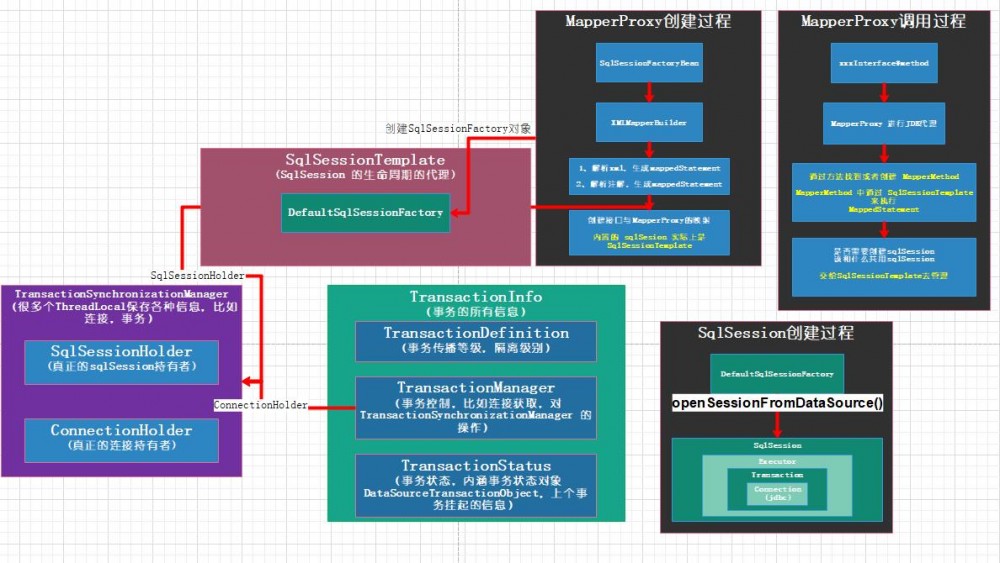
4.4 纵览流程
让我们回到第四节开头的那段很长的代码,到这里是不是很明了了:
protected Object invokeWithinTransaction(Method method, @Nullable Class<?> targetClass,
final InvocationCallback invocation) throws Throwable {
// If the transaction attribute is null, the method is non-transactional.
TransactionAttributeSource tas = getTransactionAttributeSource();
final TransactionAttribute txAttr = (tas != null ? tas.getTransactionAttribute(method, targetClass) : null);
final TransactionManager tm = determineTransactionManager(txAttr);
PlatformTransactionManager ptm = asPlatformTransactionManager(tm);
final String joinpointIdentification = methodIdentification(method, targetClass, txAttr);
if (txAttr == null || !(ptm instanceof CallbackPreferringPlatformTransactionManager)) {
// Standard transaction demarcation with getTransaction and commit/rollback calls.
TransactionInfo txInfo = createTransactionIfNecessary(ptm, txAttr, joinpointIdentification);
Object retVal;
try {
// This is an around advice: Invoke the next interceptor in the chain.
// This will normally result in a target object being invoked.
retVal = invocation.proceedWithInvocation();
}
catch (Throwable ex) {
// target invocation exception
completeTransactionAfterThrowing(txInfo, ex);
throw ex;
}
finally {
cleanupTransactionInfo(txInfo);
}
if (vavrPresent && VavrDelegate.isVavrTry(retVal)) {
// Set rollback-only in case of Vavr failure matching our rollback rules...
TransactionStatus status = txInfo.getTransactionStatus();
if (status != null && txAttr != null) {
retVal = VavrDelegate.evaluateTryFailure(retVal, txAttr, status);
}
}
commitTransactionAfterReturning(txInfo);
return retVal;
}
}
TransactionInfo
private void bindToThread() {
// Expose current TransactionStatus, preserving any existing TransactionStatus
// for restoration after this transaction is complete.
this.oldTransactionInfo = transactionInfoHolder.get();
transactionInfoHolder.set(this);
}
private void restoreThreadLocalStatus() {
// Use stack to restore old transaction TransactionInfo.
// Will be null if none was set.
transactionInfoHolder.set(this.oldTransactionInfo);
}
- 4、如果需要,则提交当前事务
- 5、返回切面值
4.5 最后一块拼图,spring 如何与 sqlSession 产生关联:
我们在第三章讲到,mybatis有一个叫做 defualtSqlSessionFactory 的类,负责创建 sqlSession ,但是它和 spring 又是怎么产生关联的呢?
答案就在于,spring 实现了自己的 TransactionFactory ,以及自己的 Transaction 对象 SpringManagedTransaction 。回顾一下 SqlSession 的创建过程:
private SqlSession openSessionFromDataSource(ExecutorType execType, TransactionIsolationLevel level, boolean autoCommit) {
Transaction tx = null;
try {
final Environment environment = configuration.getEnvironment();
final TransactionFactory transactionFactory = getTransactionFactoryFromEnvironment(environment);
tx = transactionFactory.newTransaction(environment.getDataSource(), level, autoCommit);
final Executor executor = configuration.newExecutor(tx, execType);
return new DefaultSqlSession(configuration, executor, autoCommit);
} catch (Exception e) {
closeTransaction(tx); // may have fetched a connection so lets call close()
throw ExceptionFactory.wrapException("Error opening session. Cause: " + e, e);
} finally {
ErrorContext.instance().reset();
}
}
看一下 SpringManagedTransaction 是如何管理 connection 的:
private void openConnection() throws SQLException {
this.connection = DataSourceUtils.getConnection(this.dataSource);
this.autoCommit = this.connection.getAutoCommit();
this.isConnectionTransactional = DataSourceUtils.isConnectionTransactional(this.connection, this.dataSource);
LOGGER.debug(() -> "JDBC Connection [" + this.connection + "] will"
+ (this.isConnectionTransactional ? " " : " not ") + "be managed by Spring");
}
DataSourceUtils.getConnection(this.dataSource); 划重点,里面的实现不用我多说了,我们可以看到熟悉的身影,也就是 ConnectionHolder ,连接是从这里(优先)拿的:
ConnectionHolder conHolder = (ConnectionHolder) TransactionSynchronizationManager.getResource(dataSource);
if (conHolder != null && (conHolder.hasConnection() || conHolder.isSynchronizedWithTransaction())) {
conHolder.requested();
if (!conHolder.hasConnection()) {
logger.debug("Fetching resumed JDBC Connection from DataSource");
conHolder.setConnection(fetchConnection(dataSource));
}
return conHolder.getConnection();
}
更新整套体系图:
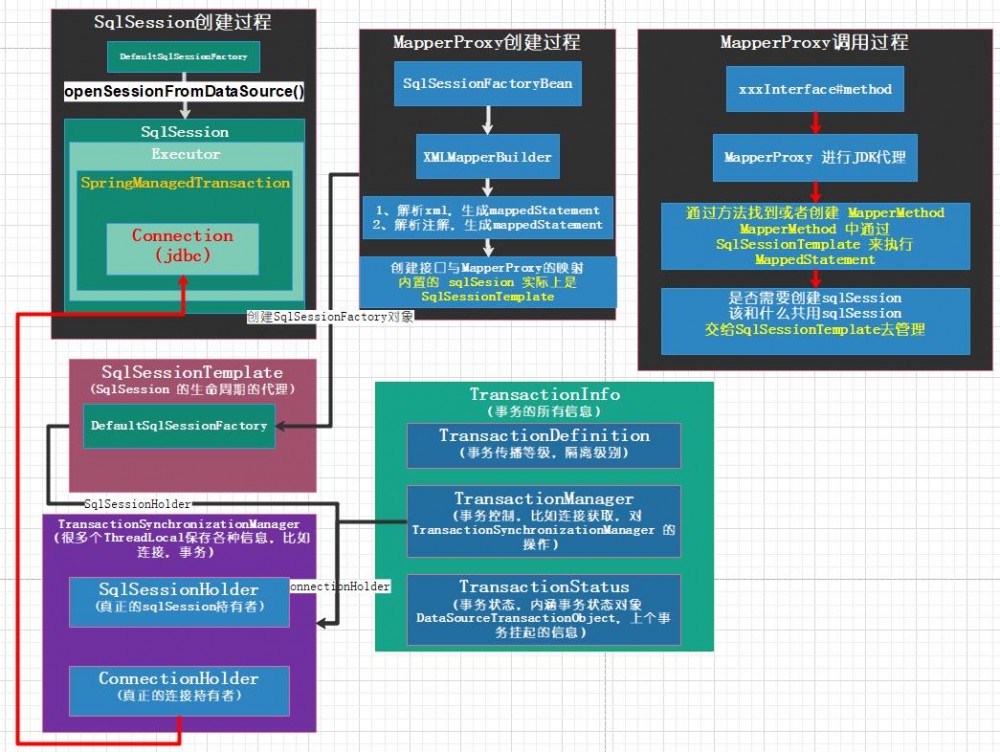
我们整体简单过一次:
- mybatis 启动时根据xml、注解创建了
mapperedStatement,用于sql执行,创建了SqlSessionFactory用于创建SqlSession对象。 - mybatis 启动时创建了
MapperProxyFactory用于创建接口的代理对象MapperProxy - 在创建
MapperProxy时,spring 为其注入了一个sqlSession用于 sql执行,但是这个sqlSession是一个代理对象,叫做sqlSessionTemplate,它会自动选择我们该使用哪个sqlSession去执行 - 在执行时,spring 切面在执行事务之前,会创建一个叫做
TransactionInfo的对象,此对象会根据事务传播等级来控制是否创建新连接,是否挂起上一个连接,将信息保存在TransactionSynchronizationManager - 到了真正需要创建或者获取
sqlSession时,spring 重写的TransactionFactory会优先去TransactionSynchronizationManager中拿连接对象。
参考资料:
mybatis-spring-boot-starter 2.1.1
mybatis 3.5.3
- 本文标签: AOP equals 缓存 源码 struct sql API parse 参数 DDL producer SQL执行 Collection session Proxy ssl tomcat apr 管理 解析 mybatis src message mapper IO ConcurrentHashMap newProxyInstance apache cat NSA App REST build autocommit SqlSessionFactory 图片 HashMap Statement update jetty 线程 IDE CTO list example 文章 ORM Lua JDBC java 自动化 数据库 数据 CEO value Connection ACE bean executor bug synchronized spring tk db find UI 注释 key dataSource strace Action cache id 静态方法 rmi stream node tar 配置 响应式 XML 总结 生命 Property StatementHandler iBATIS JVM zab tab https map 代码 Select final http Persistence sqlsession
- 版权声明: 本文为互联网转载文章,出处已在文章中说明(部分除外)。如果侵权,请联系本站长删除,谢谢。
- 本文海报: 生成海报一 生成海报二











![[HBLOG]公众号](https://www.liuhaihua.cn/img/qrcode_gzh.jpg)

